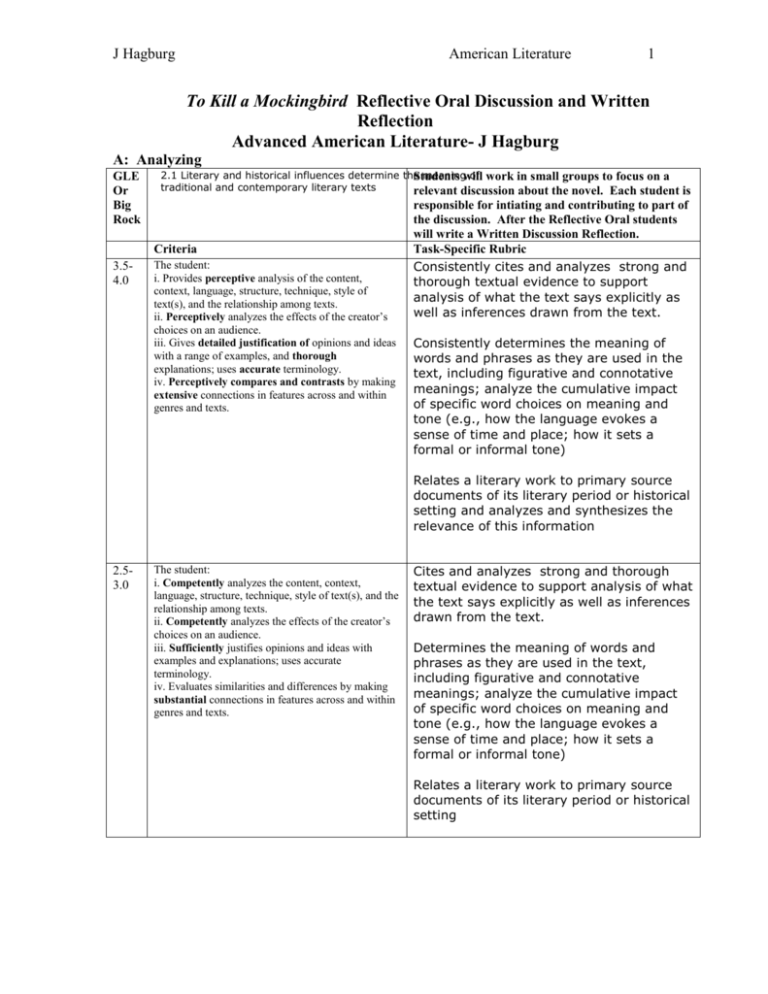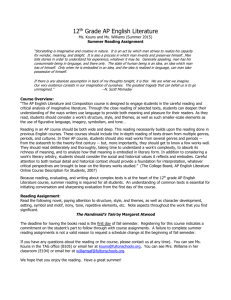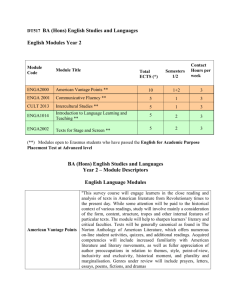Course/Unit Title:
advertisement

J Hagburg American Literature 1 To Kill a Mockingbird Reflective Oral Discussion and Written Reflection Advanced American Literature- J Hagburg A: Analyzing GLE Or Big Rock 2.1 Literary and historical influences determine the meaningwill of work in small groups to focus on a Students traditional and contemporary literary texts relevant discussion about the novel. Each student Criteria 3.54.0 The student: i. Provides perceptive analysis of the content, context, language, structure, technique, style of text(s), and the relationship among texts. ii. Perceptively analyzes the effects of the creator’s choices on an audience. iii. Gives detailed justification of opinions and ideas with a range of examples, and thorough explanations; uses accurate terminology. iv. Perceptively compares and contrasts by making extensive connections in features across and within genres and texts. is responsible for intiating and contributing to part of the discussion. After the Reflective Oral students will write a Written Discussion Reflection. Task-Specific Rubric Consistently cites and analyzes strong and thorough textual evidence to support analysis of what the text says explicitly as well as inferences drawn from the text. Consistently determines the meaning of words and phrases as they are used in the text, including figurative and connotative meanings; analyze the cumulative impact of specific word choices on meaning and tone (e.g., how the language evokes a sense of time and place; how it sets a formal or informal tone) Relates a literary work to primary source documents of its literary period or historical setting and analyzes and synthesizes the relevance of this information 2.53.0 The student: i. Competently analyzes the content, context, language, structure, technique, style of text(s), and the relationship among texts. ii. Competently analyzes the effects of the creator’s choices on an audience. iii. Sufficiently justifies opinions and ideas with examples and explanations; uses accurate terminology. iv. Evaluates similarities and differences by making substantial connections in features across and within genres and texts. Cites and analyzes strong and thorough textual evidence to support analysis of what the text says explicitly as well as inferences drawn from the text. Determines the meaning of words and phrases as they are used in the text, including figurative and connotative meanings; analyze the cumulative impact of specific word choices on meaning and tone (e.g., how the language evokes a sense of time and place; how it sets a formal or informal tone) Relates a literary work to primary source documents of its literary period or historical setting J Hagburg 1.52.0 0.51.0 GLE Or Big Rock 3.54.0 American Literature The student: i. Provides adequate analysis of the content, context, language, structure, technique and style of text(s), and the relationship among texts. ii. Provides adequate analysis of the effects of the creator’s choices on an audience. iii. Justifies opinions and ideas with some examples and explanations, though this may not be consistent; uses some terminology. iv. Evaluates some similarities and differences by making adequate connections in features across and within genres and texts. 2 Rarely cites and analyzes strong and thorough textual evidence to support analysis of what the text says explicitly as well as inferences drawn from the text. Rarely determines the meaning of words and phrases as they are used in the text, including figurative and connotative meanings; analyze the cumulative impact of specific word choices on meaning and tone (e.g., how the language evokes a sense of time and place; how it sets a formal or informal tone) The student: i. Provides limited analysis of the content, context, language, structure, technique and style of text(s), and the relationship among texts. ii. Provides limited analysis of the effects of the creator’s choices on an audience. iii. Rarely justifies opinions and ideas with examples or explanations; uses little or no terminology. iv. Evaluates few similarities and differences by making minimal connections in features across and within genres and texts. 1.1 Content that is gathered carefully and organized well successfully influences an audience 1.2 Effectively operating in small and large groups to accomplish a goal requires active listening Criteria The student: i. Provides perceptive analysis of the content, context, language, structure, technique, style of text(s), and the relationship among texts. ii. Perceptively analyzes the effects of the creator’s choices on an audience. iii. Gives detailed justification of opinions and ideas with a range of examples, and thorough explanations; uses accurate terminology. iv. Perceptively compares and contrasts by making extensive connections in features across and within genres and texts. Students will work in groups of 3-5 to discuss the novel and identify and discuss: What is the historical, social, and cultural context of the novel? RE-1 Task-Specific Rubric Consistently Present information, findings, and supporting evidence clearly, concisely, and logically such that listeners can follow the line of reasoning and the organization, development, substance, and style are appropriate to purpose, audience, and task. Lead, Initiate and participate effectively in a range of collaborative discussions with diverse partners on grades 9–10 topics, texts, and issues, building on others’ ideas and expressing their own clearly and persuasively. Come to discussions prepared, having read and researched material under study; J Hagburg American Literature 3 explicitly draw on that preparation by referring to evidence from texts and other research on the topic or issue to stimulate a thoughtful, wellreasoned exchange of ideas. 2.53.0 The student: i. Competently analyzes the content, context, language, structure, technique, style of text(s), and the relationship among texts. ii. Competently analyzes the effects of the creator’s choices on an audience. iii. Sufficiently justifies opinions and ideas with examples and explanations; uses accurate terminology. iv. Evaluates similarities and differences by making substantial connections in features across and within genres and texts. Present information, findings, and supporting evidence clearly, concisely, and logically such that listeners can follow the line of reasoning and the organization, development, substance, and style are appropriate to purpose, audience, and task. Initiate and participate effectively in a range of collaborative discussions with diverse partners on grades 9–10 topics, texts, and issues, building on others’ ideas and expressing their own clearly and persuasively. Come to discussions prepared, having read and researched material under study; explicitly draw on that preparation by referring to evidence from texts and other research on the topic or issue to stimulate a thoughtful, wellreasoned exchange of ideas. 1.52.0 0.51.0 . The student: i. Provides adequate analysis of the content, context, language, structure, technique and style of text(s), and the relationship among texts. ii. Provides adequate analysis of the effects of the creator’s choices on an audience. iii. Justifies opinions and ideas with some examples and explanations, though this may not be consistent; uses some terminology. iv. Evaluates some similarities and differences by making adequate connections in features across and within genres and texts. Student rarely meets grade level standards and does not apply learned information or skills. Rarely presents information, findings, and supporting evidence clearly, concisely, and logically such that listeners can follow the line of reasoning and the organization, development, substance, and style are appropriate to purpose, audience, and task. Rarely initiates and participate effectively in a range of collaborative discussions with diverse partners on grades 9–10 topics, texts, and issues, building on others’ ideas and expressing their own clearly and persuasively. Does not come to discussions prepared, having read and researched material under study; explicitly draw on that preparation by referring to evidence from texts and other research on the topic or issue to stimulate a thoughtful, wellreasoned exchange of ideas. Does not participate J Hagburg GLE Or Big Rock 7-8 American Literature Topic/ Task (3.1) Literary or narrative genres feature a variety of stylistic devices to engage or entertain an audience MYP Criteria Student consistently and thoroughly exceeds grade level standards and is able to apply them almost faultlessly in a wide variety of situations. The student demonstrates originality and insight and always produces work of high quality. In a Written Discussion Reflection, students will write a short reflection which based upon the essential question: How was your understanding of the historical, social, and cultural contexts of the novel developed through the Reflective Oral Discussion? RE-1 3.5-4.0 Task-Specific Rubric Students can: 1. Write narratives to develop and analyze real or imagined experiences or events using effective technique, well-chosen details, and well-structured event sequences. 2. Use precise words and phrases, telling details, and sensory language to convey a vivid picture of the experiences, events, setting, and/or characters 3. Write literary and narrative texts applying a wide range of stylistic devices (poetic techniques, figurative language, imagery, graphic elements) to support the presentation of implicit or explicit theme 2.5-3.0 Students can: 1. Write narratives to develop real or imagined experiences or events using effective technique, wellchosen details, and well-structured event sequences. 2. Use precise words and phrases, telling details, and sensory language to convey a vivid picture of the experiences, events, setting, and/or characters. 3. Write literary and narrative texts using a range of stylistic devices (poetic techniques, figurative language, imagery, graphic elements) to support the The student: i. Produces texts that demonstrate a high degree of personal engagement with the creative process; demonstrates a high degree of insight, imagination or sensitivity and perceptive exploration of and critical reflection on new perspectives and ideas. ii. Makes perceptive stylistic choices in terms of linguistic, literary and visual devices, demonstrating good awareness of impact on an audience. iii. Selects extensive relevant details and examples to develop ideas with precision. 5-6 4 Student consistently meets and sometimes exceeds grade level standards and is able to apply learned information and skills to new and unfamiliar situations independently. The student: i. Produces texts that demonstrate considerable personal engagement with the creative process; demonstrates considerable insight, imagination or sensitivity and substantial exploration of and critical reflection on new perspectives and ideas. ii. Makes thoughtful stylistic choices in terms of linguistic, literary and visual devices, demonstrating good awareness of impact on an audience. iii. Selects sufficient relevant details and examples to develop ideas with precision. J Hagburg American Literature 5 presentation of implicit or explicit theme 3-4 Student sometimes meets grade level standards and uses regular adult support to apply learned information and skills to some new or unfamiliar situations. 1.5-2.0 The student: i. Produces texts that demonstrate adequate personal engagement with the creative process; demonstrates some insight, imagination or sensitivity and some exploration of and critical reflection on new perspectives and ideas. ii. Makes some stylistic choices in terms of linguistic, literary and visual devices, demonstrating adequate awareness of impact on an audience. iii. Selects some relevant details and examples to develop ideas. 0.51.0 Student rarely meets grade level standards and does not apply learned information or skills. Students can: 1. Write narratives to develop real or imagined experiences or events using some effective technique, well-chosen details, and wellstructured event sequences. 2. Use ver y few precise words and phrases, telling details, and sensory language to convey a vivid picture of the experiences, events, setting, and/or characters. 3. Write literary and narrative texts using a limited range of stylistic devices (poetic techniques, figurative language, imagery, graphic elements) to support the presentation of implicit or explicit theme 0.5-1.0 D: Using Language GLE 3.3-Grammar, language usage, mechanics, and clarity are the basis of ongoing refinements and revisions within the writing process. Topic/ Task How is your understanding of the text affected by the various historical, social and cultural contexts? IB 7-8 Criteria RE-1 3.5-4.0 Task-Specific Rubric Student applies concepts of language to create a well-designed analysis of text. 5-6 The student: i. Effectively uses a range of appropriate vocabulary, sentence structures and forms of expression. ii. Writes and speaks in a consistently appropriate register and style that serve the context and intention. iii. Uses grammar, syntax and punctuation with a high degree of accuracy; errors are minor and communication is effective. iv. Spells/writes and pronounces with a high degree of accuracy; errors are minor and communication is effective. v. Makes effective use of non-verbal communication techniques. The student: i. Uses a varied range of appropriate vocabulary, sentence structures and forms of expression competently. ii. Writes and speaks competently in a register and style that serve the context and intention. iii. Uses grammar, syntax and punctuation with considerable degree of accuracy; errors do not hinder communication. iv. Spells/writes and pronounces with a considerable degree of accuracy; errors do not hinder effective 2.5-3.0 MLA Style is consistent and presented using a high degree of accuracy with few errors. Apply knowledge of language to understand how language functions in different contexts, to make effective choices for meaning or style, and to comprehend more fully when reading or listening. Write and edit work so that it conforms to the guidelines in a style manual (e.g., MLA Handbook, Turabian’s Manual for Writers) J Hagburg 3-4 1-2 communication. v. Makes sufficient use of non-verbal communication techniques. The student: i. Uses a adequate range of appropriate vocabulary and forms of expression. ii. Sometimes writes and speaks in a register and style that serve the context and intention. iii. Uses grammar, syntax and punctuation with some degree of accuracy; errors sometimes hinder communication. iv. Spells/writes and pronounces with some degree of accuracy; errors sometimes hinder communication. v. Makes some use of non-verbal communication techniques. The student: i. Uses a limited range of appropriate vocabulary and forms of expression. ii. Writes and speaks in an inappropriate register and style that do not serve the context and intention. iii. Uses grammar, syntax and punctuation with limited accuracy; errors often hinder communication. iv. Spells/writes and pronounces with limited accuracy; errors often hinder communication. v. Makes limited and/or inappropriate use of nonverbal communication techniques. American Literature 6 appropriate for the discipline and writing type. 1.5-2.0 0.5-1.0 Student has constructed a basic analysis of text that includes some aspects of language functions within the writing. MLA style has some errors that affect the accuracy and development of the writing.









